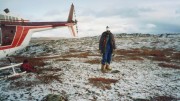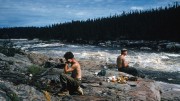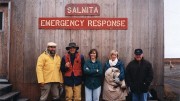The idea of flying prospectors and supplies into the field occurred to John Hammel in 1925, when he engaged the air service branch of the Ontario Department of Lands and Forests to fly 15 tons of supplies, seven men and a female cook from the railroad to Red Lake, a distance of 100 miles.
Hammell had agreed to option the Howey Gold discovery to Dome Mines of South Porcupine, which the company had to clear, strip and trench for samples in order to determine the average gold content per ton. (Howey Gold was the pioneer operator in the Red Lake area.)
One of the six pilots of the Provincial Air Service at that time was Harold Oaks, who was also a graduate mining engineer. Oaks formed Patricia Airways & Exploration Co. in 1927 and bought a new Curtiss Lark Aircraft, which he flew commercially to earn revenue.
Hammell then formed the Northern Aerial Mineral Exploration Co. in 1927, for which Oaks later flew as chief pilot.
Still another air service that took shape in the gold rush to Red Lake came with the formation of Prospectors Airways, when Lloyd Rochester and his partner, Bobby Cockeram, came to Sioux Lookout in September 1926 and flew into Red Lake in one hour. That was a trip that usually took about six days by canoe or a fast dog team in the winter.
Cockeram had been to Red Lake twice by canoe and became fully convinced that flying would save a lot of time.
As he had never flown before, he readily agreed when Rochester suggested that they buy an aircraft and form a company to prospect and earn revenue.
Prospector Airways was thus born in 1927, and among its pilots were Clarence Tuer of Haileybury, Peter Graham of New Liskeard, and Glyngaurd Burge of Great Britain.
They bought a new Fairchild 51 aircraft from a company in New Jersey and named the plane Prospector. The following year, they followed that up with two de Havilland Moths.
Rochester, who had been a pilot in the First World War and was a graduate of mining engineering from McGill University, flew one of the moths, and Cockeram, who had managed to get his pilot’s licence, flew the other.
They made notable contributions to mining aviation history in Canada until they were absorbed some 36 years later by Kerr Addison Mines.
Dominion Explorers Airways was formed in 1927, and in the following year, Sioux Lookout became the busiest airport in Canada — it being the flying base for Western Canada Airways, Northern Mineral Explorations, Dominion Explorers, Patricia Airways, the air branch of Consolidated Mining & Smelting and the Ontario Provincial Air Service forestry patrol branch.
By the summer of 1936, Red Lake had become one of the busiest airports in the world, with more than 1,000 landings and takeoffs daily from the 35 float-equipped aircraft based there.
In 1937, to add to its laurels, Red Lake handled 50% more freight than any other airport in the world.
— This column originally appeared in the Dec. 21, 1987, issue of The Northern Miner. The author, who recently died, was an operating engineer in the Red Lake camp. He wrote several books about mining in the area.




Be the first to comment on "Odds ‘n’ sods: Flying over Red Lake"